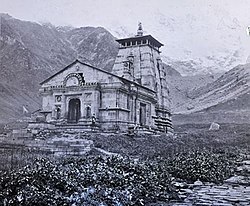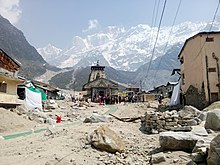Kedarnath Temple
| Kedarnath Temple | ||
|---|---|---|
 Kedarnath Temple |
||
| Data | ||
| place | Kedarnath in Uttarakhand (India) | |
| Coordinates | 30 ° 44 ′ 0 ″ N , 79 ° 4 ′ 0 ″ E | |
|
|
||
The Kedarnath Temple ( Hindi : केदारनाथ मंदिर , Kēdārnāth Mandir ) is an important shrine of Hinduism in the Indian state of Uttarakhand . It belongs to the twelve Jyotirlingas and is therefore one of the most important Shiva temples in India; Shiva is worshiped here as Kedarnath ("Lord of the land of Kedar"). Next here is one of four sites on the Chota Char Dham pilgrimage route.
location
The temple is located in Kedarnath, about 50 km as the crow flies from the border with China or Tibet . The place is located in a high valley through which the Mandakini River , a tributary of the Ganges , flows. The valley is located on the south side of the Himalaya mountains at an altitude of approx. 3580 m above sea level. d. M. in the south of the Gangotri National Park .
myth
The genesis of the Kedarnath Temple goes back to the five Pandava brothers, heroes of the epic Mahabharata . They are said to have built a previous building on the site of today's temple. After the great Kurukshetra War, they came to Kedarnath as old men to repent before Shiva for their deeds. However, the god was hiding, he had taken the form of a buffalo. Bhima , the strongest of the Pandava brothers, pursued him and pulled his tail. The buffalo bull then split into several parts. Only the back of his body was visible as a small hill. At this point a Jyotirlingam finally appeared , a "lingam of light" from which Shiva appeared. He promised his help to everyone who would worship him here in this form. Thus the Pandavas had achieved their goal and were free from their misdeeds.
The temple
According to tradition, the temple was built more than 1000 years ago by one of the greatest Hindu philosophers and saints, Shankara , called Adi Shankaracharya . This is where he spent the last years of his life, and many Hindus assume that his grave is right behind the building. The building consists of large, evenly hewn gray stone slabs. The exact age of the sanctum ( garbhagriha ) is unknown, but the vestibule ( mandapa ) with its alpine-looking gable facade and its saddle roof dates from the 18th century; The rather unadorned Shikhara tower may also have been built or reconstructed during this period. The inner walls are decorated with various deities and scenes from Hindu mythology. There are also statues of the Pandava brothers and Draupadi is also said to be shown. In the center of the cella ( garbhagriha ) is a Shiva lingam . In front of the temple there is a large statue of the Nandi bull, the “mount” ( vahana ) of Shiva in the open air .
Surroundings
The other body parts of the Shiva bull manifested themselves in four different places in the Himalayas, they are known as "Panch Kedar temples" and are identified with the nearby temples of Madhyamaheshwar, Tunganath, Kalpeshwar and Rudranath , which are mostly similar in architectural terms .
Flood disaster 2013
After heavy rain it came on 16./17. June 2013 on the departure of several mud and debris avalanches, which also included the Kedarnath Temple, which, however, remained largely unscathed. Most of the village was destroyed by the avalanches. The temple was probably spared because a large boulder came to a standstill just before the temple and the subsequent flood of mud and debris bypassed both sides of the temple.
Web links
Individual evidence
- ↑ Shradha Shahani: How Kedarnath temple survived the flood and 400 years under snow. Condé Nast Traveler, December 6, 2018, accessed February 8, 2019 .


